
The U.S. state of West Virginia currently has two congressional districts, each represented by a member of the United States House of Representatives.

The U.S. state of West Virginia currently has two congressional districts, each represented by a member of the United States House of Representatives.
List of members of the United States House delegation from West Virginia, district boundaries, and the district political ratings according to the CPVI. The delegation has a total of two members, both of whom are Republicans.
| Current U.S. representatives from West Virginia | |||||
|---|---|---|---|---|---|
| District | Member (Residence) [1] | Party | Incumbent since | CPVI (2022) [2] | District map |
| 1st |  Carol Miller (Huntington) | Republican | January 3, 2019 | R+23 |  |
| 2nd |  Alex Mooney (Charles Town) | Republican | January 3, 2015 | R+22 |  |

Table of United States congressional district boundary maps in the State of West Virginia, presented chronologically. [3] All redistricting events that took place in West Virginia between 1973 and 2013 are shown.
| Year | Statewide map |
|---|---|
| 1973–1982 |  |
| 1983–1992 | 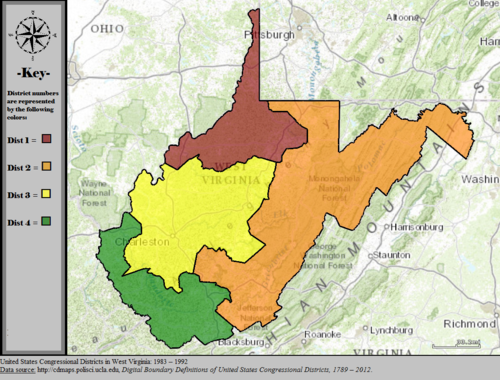 |
| 1993–2002 |  |
| 2003–2013 | 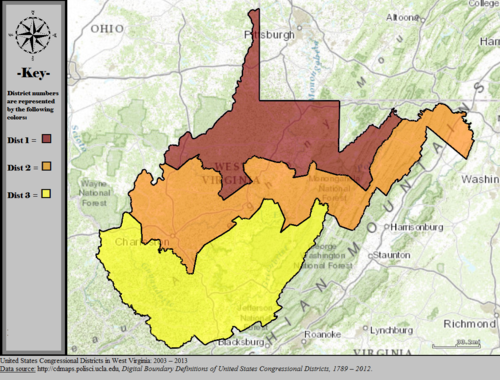 |
| 2013–2023 |  |
The 3rd district was eliminated by the 2020 United States census.
The 4th district was eliminated by the 1990 United States census.
The 5th district was eliminated by the 1970 United States census.
The 6th district was eliminated by the 1960 United States census.
West Virginia's at-large congressional district existed between 1913 and 1917, during a period when the state failed to enact a redistricting plan that allowed for a new sixth district. Such a plan was adopted for the 1916 elections, making the at-large seat obsolete.

The U.S. state of Oregon has had six United States congressional districts since 2023, when the 6th district was created as a result of the 2020 census. The 5th district was added as a result of the 1980 census, and boundaries were redrawn following the population changes to each district as determined by the 1990, 2000, 2010, and 2020 censuses.

These are tables of congressional delegations from the State of Texas to the United States Senate and United States House of Representatives.

Kansas is divided into 4 congressional districts, each represented by a member of the United States House of Representatives. The number of districts in Kansas remained unchanged after the 2010 census. Historically, the state has held as many as eight seats (1893–1933). The number of congressional seats decreased from five to four following the 1990 census. Between 1990 and 2000, the population of Kansas grew by 8.5% from 2,477,574 to 2,688,418, making it the 32nd most populated state; all four congressional seats were retained.
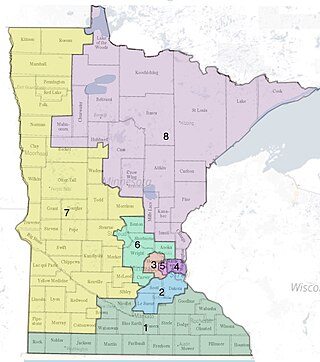
Minnesota is currently divided into eight congressional districts, each represented by a member of the United States House of Representatives. After the 2020 census, the number of Minnesota's seats remained unchanged.

Nebraska has three congressional districts due to its population, each of which elects a member to the United States House of Representatives.

Indiana has nine congressional districts. They were last redrawn after the 2020 census and took effect in 2023, following the 2022 elections.

Kentucky is currently divided into six congressional districts, each represented by a member of the United States House of Representatives. The number of congressional districts has been set at six since the 1990 redistricting cycle.

Illinois is divided into 17 congressional districts, each represented by a member of the United States House of Representatives. The majority of Illinois' districts are located in the Chicago area.

Wisconsin is currently divided into 8 congressional districts, each represented by a member of the United States House of Representatives. After the 2020 census, the number of Wisconsin's seats remained unchanged.
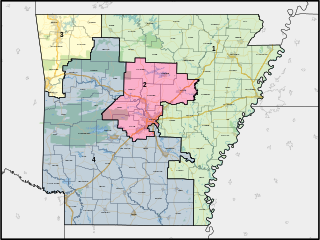
The U.S. state of Arkansas currently has four United States congressional districts. The state has had as many as seven districts; the 5th district existed from 1883 through 1963. The 6th existed from 1893 to 1963. The 7th existed from 1903 to 1953. No Democrat has won a House seat in the state since 2012.

Virginia is currently divided into 11 congressional districts, each represented by a member of the United States House of Representatives. The death of Rep. Donald McEachin on November 28, 2022, left the 4th congressional district seat empty. Following the results of a special election to fill his seat on February 21, 2023, Jennifer McClellan made history by becoming Virginia's first black congresswoman.
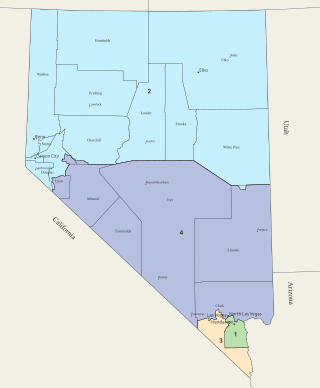
Nevada is divided into four congressional districts, each represented by a member of the United States House of Representatives. After the 2010 census, Nevada gained a fourth House seat.
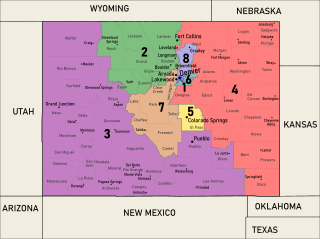
Colorado is divided into eight congressional districts, each represented by a member of the United States House of Representatives.

Utah is divided into 4 congressional districts, each represented by a member of the United States House of Representatives. After the 2010 census, Utah gained one House seat, and a new map was approved by the state legislature and signed into law by Governor Gary Herbert.

Mississippi is currently divided into 4 congressional districts, each represented by a member of the United States House of Representatives. After the 2020 census, the number of Mississippi's seats remained unchanged.

Iowa is divided into four congressional districts, each represented by a member of the United States House of Representatives. The state's congressional map is roughly divided by quadrants in the northeast, northwest, southeast, and southwest sections of Iowa.
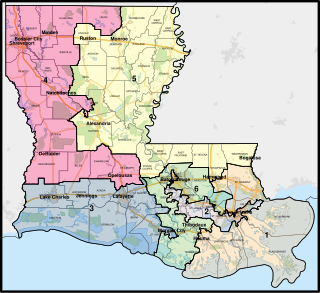
The U.S. state of Louisiana currently has six congressional districts. The state has had as many as eight districts; the eighth district was eliminated on January 9, 1993 after results of the 1990 census, and the seventh district was eliminated in 2013 post Hurricane Katrina population stagnation after the results of the 2010 census.

The following is a list of the ten congressional districts in the U.S. state of Washington. From the time that Washington Territory was formed in 1853, through statehood in 1889, Washington Territory elected an at-large non-voting Delegate to the United States House of Representatives. At different times in its history, the state of Washington has also elected one or more representatives At-large statewide. Washington gained its 10th district following reapportionment after the 2010 census.

New Hampshire is divided into two congressional districts, each represented by a member of the United States House of Representatives.

Maryland is divided into eight congressional districts, each represented by a member of the United States House of Representatives. After the 2020 census, the number of Maryland's seats remained unchanged, giving evidence of stable population growth relative to the United States at large.